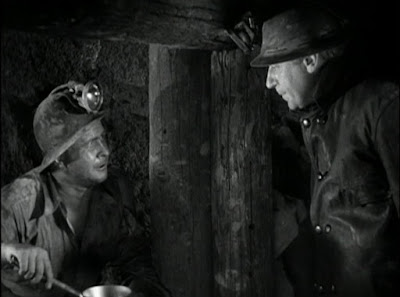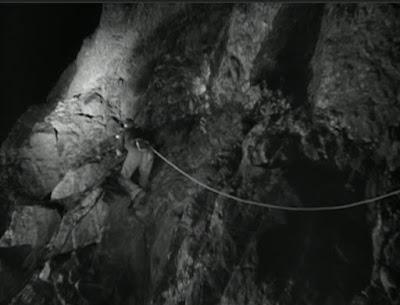This week I drill down (pun intended!) into the realm of the 'B' picture. While exploring Draegerman Courage, I had the opportunity to learn more about the role of B pictures in Hollywood and the mid-century film-going experience.
Draegerman Courage 1937
Director: Louis King
Writer: Anthony Coldeway
Cinematographer: Gilbert Warrenton
Produced by: Bryan Foy for Warner Bros.
Starring: Jean Muir, Barton MacLane, Henry O'Neill
Why I chose it
Ever since I learned of this movie's existence, I've wanted to see it - and really only because I once worked for the company Draeger. The term 'draegerman' was, and still is, used in the U.S. and Canada for mine rescue workers who typically used safety equipment made by the company.
'No-spoiler' plot overview
In Nova Scotia, 'Draegerman' Andrew "Beau" Beaupre (Barton MacLane) warns the foreman in the "New Moon" Gold Mine that proper safety precautions are not being followed. He's brushed off, and predictably, a fatal accident occurs in the mine. Meanwhile, Dr. Thomas Haslett (Henry O'Neill) attends to the victims, while managing a home life with frisky tween Suzie (Priscilla Lyon) and adult daughter Ellen (Jean Muir), who is dating Beau. Dr. Haslett dreams of a better hospital and looks to sell his ownership share in the ominously named defunct 'Graveyard Mine' to fund it. A freak non-mine-related accident injures Suzie, whose expensive operation prompts the Doctor to sell low to New Moon owner Martin Crane (Robert Barrat). He, Crane, and foreman Mac (Addison Richards) make their way to the 'Graveyard' mine, just to be trapped at the lowest level by an ill-timed cave-in. Beau is pressed into duty to rescue them.
Production Background and the Warner Bros. 'B' Unit
In Hollywood, "B" movies were those designed and produced at lower budgets to be sold as a 'second feature' on a double bill in smaller-market cinemas whose patrons demanded more value for their money, especially during the Depression. B movies got their own production units at the major studios, whereas the smaller studios produced only B movies. Typically running no longer than an hour, these productions employed lesser-known actors or starred actors who only filled supporting roles in A pictures, and scripts, sets, etc. were usually mediocre. Yet many of these films are memorable today for a variety of reasons. The beloved series like Torchy Blane, Charlie Chan, or the 'singing cowboy' Westerns, were popular with the public. Today's film aficionados cite the creativity that emerged when talented directors were constrained, in low-budget noir gems like Detour, or The Narrow Margin.
At Warner Bros., the 'B Unit' produced approximately half of all the studio's movies during this era. Set up in 1935 and run by Bryan Foy, late of the "Seven Little Foys" of Vaudeville, the unit produced ~30 films per year at $50,000-$125,000 per film.* Foy had considerable autonomy as major studio bosses Hal Wallis and Jack Warner were busy with the A pictures. But like the studio A pictures, Foy's Unit often focused on gritty, 'ripped from the headlines', or social issue dramas. Draegerman Courage definitely fit that mold.
 |
| Bryan Foy (imdb.com) |
While not stated anywhere in the film credits, the movie was based on a Nova Scotia mine accident (Moose River) just the year before that captivated all Canada because of three-minute CBC radio broadcasts from the site every half hour. Like the movie, a doctor and two other men were trapped for 11 days, and one perished before he could be rescued. (Go here for a detailed description of what actually happened at the Goose River Mine). The film's writers chose to play up the struggle between workers ekeing out a living while greedy owners cut corners in safety measures, eventually having to pay for those sins. For the film's hero, actor Barton MacLane was chosen, who never played the lead in any A picture, but was often in support in films like The Maltese Falcon and High Sierra. Second-lead actress Jean Muir, who later was blacklisted for her alleged Communist-supporting activities, filled the role of the love interest.
The film garnered at least a couple of good reviews at the time. In Variety: "Warners has turned out a vivid and often thrilling melodrama of underground disaster....The film can boast of a well-managed plot, top-notch dialog, and a story that lifts to its climax with smoothness and dispatch."
Some other notable film-related events in 1937 (from Filmsite.org):
- Luise Rainer won the second of her back-to-back Best Actress Oscars for her performance as the strong and silent O-Lan, a self-sacrificing Chinese peasant farm wife in The Good Earth (1937). Her first win was for her performance in The Great Ziegfeld (1936).
- Chester Gould's comic strip police detective character Dick Tracy made his first appearance in film in Dick Tracy (1937), a Republic Pictures movie serial starring Ralph Byrd.
- Six of the original members of "The Dead End Kids" (young New York actors) reprised their 1935-1937 Broadway stage roles in the Hollywood film version, UA's crime drama Dead End (1937) opposite Humphrey Bogart. It was their first film appearance, and they went on to make more films, including Warners' popular Angels With Dirty Faces (1938).
- In a poll taken by newspaper entertainment columnist and radio star Ed Sullivan (later a legendary TV variety show host) in 53 newspapers in 1937, 20 million fans voted Clark Gable and Myrna Loy as the "King and Queen of Hollywood."
My Random Observations
- B pictures required economy in storytelling, and man, this one had it. I was struck by all the goings-on that occurred within the hour: three terrible accidents, two deaths, two daring rescues, a bar fight, a romance on-the-rocks, a family melodrama, a baby's birth and baptism, a cute dog doing tricks. I'm sure I missed some things.
- Building on that, I was impressed by the seamless integration of all these elements in the movie. I caught myself wondering at times if the movie was supposed to be a family drama or a disaster movie, but I went along for the ride. While the characters themselves were mostly two-dimensional, the actors brought enough skill to their performances to make us understand and empathize with most of them.
- Actor Henry O'Neill (Dr. Tom Haslett), was perhaps the most nuanced of the group. And he was immediately identifiable to me. I had to look him up, but he was in over 150 films in the 30s and 40s, including Johnny Eager, Jezebel and at least a dozen others that I've seen. He brought an air of sternness but kind vulnerability that worked well for him here.
- What was Ellen Haslett's role in society, exactly? She seemed to be a young adult still living at home. She wasn't needed to care for elderly parents or even her younger sister, since her mother ran the house. She seemed to exist only to make coffee to bring to the mine rescue workers, or wait around until Beau popped the question. She had no dreams or character arc, and did not take any actions to move the plot along. (Obviously, the answer here is she really only existed to provide the requisite love interest). I wonder if audiences in the 1930s asked this question or to what extent this lifestyle was common for young women then.
- I was somewhat disappointed in only about three passing references to 'Draegermen', despite the term being in the film's title. I thought the film might feature a bit of explanation of what kind of safety equipment Draeger made, at the very least, for mine rescue workers, or a brief history of Draegermen. No luck there.
 |
| Miners at the 'New Moon' rush to escape the falling timbers as the mine interior structure crumbles around them. |
 |
| Draegerman 'Beau' (Barton MacLane, left) fills in Dr. Thomas Haslett (Henry O'Neill) about the possible conditions of miners escaping the cave-in. |
 |
| A sweet domestic scene with young Suzy (Priscilla Lyon), her little dog, and her dad, Dr. Tom. |
 |
| Beau needs a drink after a rough day at the mine. |
 |
| Sweethearts Beau and Ellen (Jean Muir) have a moment. |
 |
| Martin Crane (Robert Barrat, left) is a bit skeptical when Dr. Haslett extols the virtues of the 'Graveyard' mine. |
 |
| Descending into the 'Graveyard' |
 |
| Villagers rush to the Graveyard site as the rescue operation gets underway. |
 |
| A live radio broadcast of the rescue (Sam Hayes) is no doubt riveting for listeners. |
 |
| Dr. Haslett speaks on a phone dropped through a tube from rescuers above ground. |
 |
| Beau walks on a steep ledge in his attempt to rescue the men trapped in the 'Graveyard'. |
Check out the trailer here:
To learn about Draeger's mine safety equipment and the history of the 'draegerman', go here.

No comments:
Post a Comment